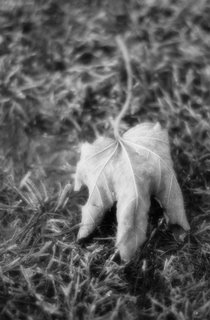
I've been thinking further about what this photography philosophy would entail, and why it's a reasonable, meaningful pursuit in the first place. Here are a few thoughts that have crossed my mind:
1) It's vital to have some sort of philosophy as a photographer. Even if you explore several, you should at least have some foundational belief system as to why you, as a person, can consider yourself a photographer. When does someone become a 'photographer' -- when he/she takes his/her first picture? When he/she downloads an image from the Internet and tweaks it into a new image (without even using a camera)? Those are tough questions to answer. Having some sort of explanation for those questions could form some foundation for a photography philosophy.
2) Since modern-day cameras are able to capture scenes so much more realistically -- even offering anti-shake technology to allow some wiggle room for folks who don't like to use tripods -- more and more people are able to take pictures that even art critics might find favorable. Anyone with a decent sense of how to use a camera and either a fat wallet or with lots of room on their credit card can go out and buy very nice cameras that help them take great pictures. So, again -- when does that person become a
photographer?
3) I suppose one could argue that a
photographer is someone who generates a decent percentage of his/her income from selling photography -- or even from teaching others about photography. But, what, then, from all the students who are learning and growing in their photographic skill? Are they not photographers? And, similarly, what about the person building a portfolio to try and break into a tough market? Just because they're not making money selling their pictures does that mean they're not a photographer? One more along these lines -- what about someone who takes a photograph shot by someone else and manipulates it in the darkroom (whether digital or otherwise) so much that it becomes their own image -- they're not using a camera, perhaps, but does that mean that they're
not a photographer, too?
These are really tough questions to answer. In thinking about these things more, I really believe that someone becomes a photographer when he/she forms some sort of philosophy and pursuit. I'm comfortable believing that a photographer must use some sort of camera -- and things like scanners and enlargers in and of themselves are not to be considered cameras. I'm not saying that the images produced with such tools aren't to be considered
art. But in my philosophy, a photographer must use some sort of camera. The thing with philosophies is that there are many of them throughout the world. No one single philosophy can contain the entirety of truth. But having a philosophy in photography certainly can help provide some motivation and some direction for capturing and creating images with the camera.






